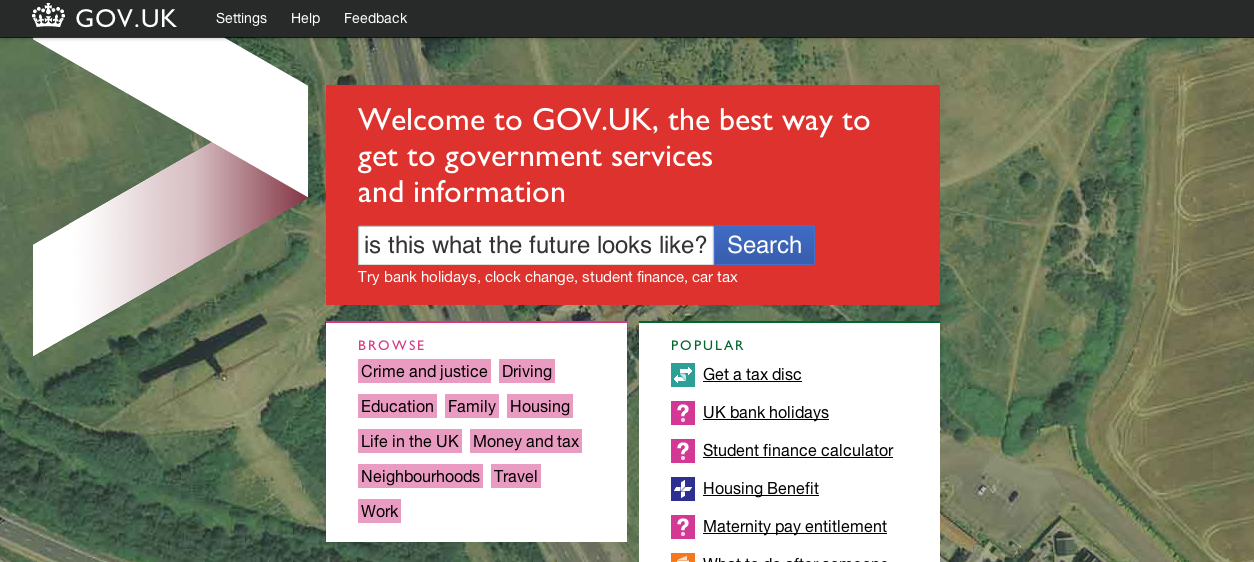
In May last year, alpha.gov.uk emerged blinking into the limelight. It was the product of a true skunkworks operation – a few guys (and they were mainly guys) – tucked away on a disused floor of a government building in south London. The site had rough edges, but it pointed in an exciting direction:
- Satisfy common requirements first
- Use fewer, better words
- Hire developers, don’t contract systems integrators
- Know – better still, create – your tools and technology stack
- Think about design and typography
- Engage with feedback as intelligent human beings
Tonight, its successor, (beta) gov.uk was revealed. While it looks different, for sure, it’s still closer to alpha.gov.uk than direct.gov.uk in scope, and you’d be forgiven for wondering what’s really changed in eight months. But lots has, even visible from the outside.
First, it’s not a skunkworks project. The Government Digital Service team responsible for gov.uk now is unrecognisable from the team in Hercules House even three or four months ago. It’s a proper organisation in a nice building, led by someone with clout, and staffed with headhunted external expertise and carefully-winnowed survivors from the projects it has taken over. There’s pace and optimism and pride in the air over there, in more concentrated form than I’ve encountered in any other part of the public sector in the last year or so.
Second: Alpha, the team behind it, and the political context into which it was born, determined that this new approach won the three-way battle of influence, leaving Directgov/The Club and Business Link/Serco effectively knocked out for the count. That victory wasn’t a given, by any means. But it matters hugely, as the internal debate switches from whether to how.
Third: the tentacles are spreading. The tweets of people like Paul Annett and Stefan Czerniawski suggest that GDSers aren’t just building the core information site now. They’re starting to get out there in the government buildings across the UK where online transactions get built for real out of monstrous Oracle databases and J2EE middleware. It’s there that the money gets wasted and the user experience for millions of people gets sacrificed, even more so than in the convoluted circumlocutions of Whitehall press releases. It’s not visible on gov.uk yet, but it’s coming.
So, it must be a fantastic feeling for the GDS team to have got this far, having built something truly elegant – designed, in the real sense of the word – in a way that government’s digital presence often hasn’t been.
But they’ll know too just how far there is to go:
- it has to scale, assimilating more of the online experience end-to-end, for businesses as well as citizens, somehow providing an elegant solution for edge cases as well as the popular ones. Revolutionising how news and policy content is created and opened up for public participation is in itself a huge challenge.
- it needs to practice selective deafness, smiling at but ignoring those with apparently reasonable but ultimately harmful requests to pull the project in a thousand different directions.
- it needs to box clever, now there’s a big target painted on its rear, and find ways of persuading those in and around government’s existing online services that the vision can include them, will benefit from their experience, and that they’ll benefit from being involved (with judicious use of a bit of my-road-or-the-high-road)
- it needs to turn digital by default from a slogan to a fact of life within government, overcoming decades of reliance on advertising, grid-led communications and reluctance to let daylight in upon magic both in terms of process and policy. I’m conscious of straying close to cliché there, but ultimately GDS needs to show that decisions based on analytical data and user-centred design lead to better outcomes than those based on seniority or consensual expediency, and that alone is a huge challenge.
Gov.uk is a stake in the ground – a signpost to something better and some examples of what that looks like, as much in terms of process and culture as in terms of pixels. If it can manage the transition to the next stage, it’ll be onto a winner and we’ll all be the better for it.

Comments
[…] O’Reilly piece did a really nice job of setting it in the bigger picture and closer to home Steph wrote an insightful post. Also Dominic pretty much summed up the importance of the open source methodology with this one […]
“They’re starting to get out there in the government buildings across the UK where online transactions get built for real out of monstrous Oracle databases and J2EE middleware. It’s there that the money gets wasted and the user experience for millions of people gets sacrificed …”.
This made me bristle when I first read it, but I understand your point of view. I work in a public sector organisation with an out-of-date Oracle database and J2EE middleware. We have limited resources; if HM government want to improve public services they should invest in our infrastructure. We also have our own writers, content editors, designers and developers.
You need to ask whether GDS are in a position to genuinely improve the usability of our services when their London-based advisors (usually consultants, on temporary contracts) are on the other side of the country. They don’t understand the financial constraints we’re under or the minefield of regulations we have to negotiate as public-sector bodies.
Something for GDS, with their ‘headhunted external expertise’ to think about.